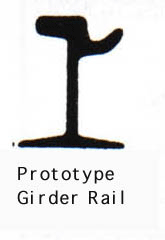David Maynard said:
Devon, I am sorry. Its my nature to try and help.
What, help me spend my money!!!(http://largescalecentral.com/externals/tinymce/plugins/emoticons/img/smiley-wink.gif)
David Maynard said:
Devon, I am sorry. Its my nature to try and help.
What, help me spend my money!!!(http://largescalecentral.com/externals/tinymce/plugins/emoticons/img/smiley-wink.gif)
John Caughey said:
Our railroads have a similar solution, but because the turns are broader we don’t need such a drastic change in wheel diameter.
In the illustration below the wheel tapers are exaggerated to show the principle;
Centrifugal force in the corners moves the wheels to the side.
Normally the flanges never touch the rail head. Only in tight curves and there they lube to reduce wear.
John
OK now that makes sense why the faces of wheels are tapered, never thought about it before but makes sense.
There used to be a you tuber with the cam hung on the truck and you could see the wheel move across the rail depending on the course followed. Most interesting to me was the flanges never touched, the weight of the car and the fillets made made that fraction of an inch count. There is a lot less wear when gravity keeps it centered.
John
Devon, its the wheel treads that are tapered. And the flanges usually don’t touch the rails, as John said. Now in the subway tunnel under Pittsburgh, there used to be a loop, and those flanges rode the rails in that loop. The sound of the flanges singing, echoed through the tunnel for quite a ways.
Devon, help you spend money? Sure! (http://largescalecentral.com/externals/tinymce/plugins/emoticons/img/smiley-wink.gif)I can do that. (http://largescalecentral.com/externals/tinymce/plugins/emoticons/img/smiley-laughing.gif)
David Maynard said:
Devon, its the wheel treads that are tapered. And the flanges usually don’t touch the rails, as John said. Now in the subway tunnel under Pittsburgh, there used to be a loop, and those flanges rode the rails in that loop. The sound of the flanges singing, echoed through the tunnel for quite a ways.
Devon, help you spend money? Sure! (http://largescalecentral.com/externals/tinymce/plugins/emoticons/img/smiley-wink.gif)I can do that. (http://largescalecentral.com/externals/tinymce/plugins/emoticons/img/smiley-laughing.gif)
Well I get that it is the wheel treads that are tapered on the regular stuff. I knew they were tapered I just never really gave any thought as to why. But what I do think is interesting is that the Hunt system and apparently the subway your speaking of actually ride on the flange, that’s goofy but sure makes sense. I think its pretty ingenuous other than the big limitation that Greg pointed out in that the radius of the corners becomes fixed in this scenario. But in a new application that can be planned around it it is way cool.
And as far as spending my money all of my “friends” on here are great at giving me all sorts of ideas that will break the bank (http://largescalecentral.com/externals/tinymce/plugins/emoticons/img/smiley-money-mouth.gif). But lets say for arguments sake that I haven’t given totally up on this idea, and yes I have, I promise, I am serious, really I have, how does one transition from riding on the tread to riding on the flange smoothly. That was never addresses in the literature and I read almost the entire thing. The top of both types of rails would have to be the same height for it to work. So some sort of transition must be made to go from tread to flange. And how would you do that from standard code 250 or 215 rail to the Ibeam you suggest. Hypothetically speaking.
Oh and what part of the wheel is the filet exactly? Am I right in thinking this is the radius portion where the tread transitions to the flange?
The fillet is a curved section between the flange and the tread. Filling in the gap in the corner made the flange stronger and increased the wheel diameter where it needed it the most. This is for the conventional inside flange.
Hey boss what should we do with this crack near the flange? Cover it with a fillet!
I love giving you more 'n more idears!
yer bud,
John
Hey I got that one right!!!
And John, your are the absolute worst. . .er. . . I mean best at giving me ideas. For the one who gave me S**t about pipe dreams you have thrown miles of pipe my way.(http://www.largescalecentral.com/externals/tinymce/plugins/emoticons/img/smiley-wink.gif)
(and I will say it before rooster does… Yes I said John throws miles of pipe my way).
I have an answer, but Mama said No.(http://www.largescalecentral.com/externals/tinymce/plugins/emoticons/img/smiley-innocent.gif)
John Longpipe(http://www.largescalecentral.com/externals/tinymce/plugins/emoticons/img/smiley-cool.gif)
John Caughey said:
I have an answer, but Mama said No.(http://www.largescalecentral.com/externals/tinymce/plugins/emoticons/img/smiley-innocent.gif)
John Longpipe(http://www.largescalecentral.com/externals/tinymce/plugins/emoticons/img/smiley-cool.gif)
lol
Dan Padova said:
I’ll post this now as I have in the past.
An architect is said to be a man who knows a very little about a great deal and keeps knowing less and less about more and more until he knows practically nothing about everything.
On the other hand, an engineer is a man who knows a great deal about very little and goes along knowing practically everything about nothing.
A contractor starts out knowing practically everything about everything but ends up knowing nothing about nothing, due to his association with architects and engineers.
LOL!!
David Maynard said:
Devon, its the wheel treads that are tapered. And the flanges usually don’t touch the rails, as John said. Now in the subway tunnel under Pittsburgh, there used to be a loop, and those flanges rode the rails in that loop. The sound of the flanges singing, echoed through the tunnel for quite a ways.
…
Devon,
On tight corners, especially in subways, they put a check rail on the inside of the curve to hold the inside wheel and reduce the strain and flange noise on the outer rail. There are “flange oilers” too, which do what they say.

Pete, yes, that’s how the real railroads do it. Light rail uses girder rail to do the same thing.

